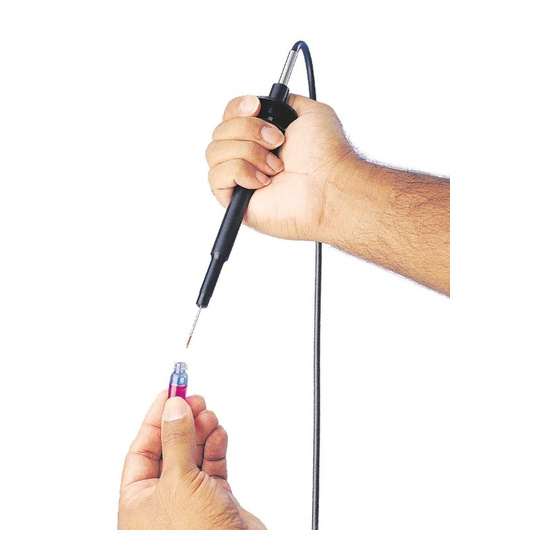Subscribe to Our Youtube Channel
Summary of Contents for WPI SpectroPipetter SPT
- Page 1 SpectroPipetter SPT & SPT-2 Miniature sample cell for microliter sampling INSTRUCTION MANUAL Serial No._____________________ 042302 World Precision Instruments, Inc.
-
Page 2: Table Of Contents
SpectroPipetter SPT & SPT-2 Contents General Warnings and Cautions ........1 Instrument Description ..........2 Wetting the sample cell for the first time ............4 Proper handling of the pipetter ..............5 Keeping the tip clean ..................6 Maintaining stability ..................8 Scattering for UV measurements .............. -
Page 3: General Warnings And Cautions
SpectroPipetter SPT & SPT-2 General Warnings and Cautions CAUTION: Do not try to dissamble the SpectroPipetter (SPT, SPT-2). Disassembly by untrained personnel will damage the unit and invalidate the warranty. CAUTION: Do not apply any mechanical force to the tip of the SpectroPipetter. -
Page 4: Instrument Description
SpectroPipetter SPT & SPT-2 Instrument Description Plunger handle — As in a standard pipetter, pushing and releasing the plunger handle drives a piston that draws in and expels fluid from the sample cell. Set screw — Two set screws on the... - Page 5 “Return” fiber. Returning light is routed to a fiber optic spectrometer. In addition to the standard accessories, the optional Ultrasonic Cleaning Kit (WPI part #UCK) is highly recommended for keeping the mirror clean and for removing any residual sample fluid or dye from the sample cell.
-
Page 6: Wetting The Sample Cell For The First Time
SpectroPipetter SPT & SPT-2 Wetting the sample cell for the first time The SpectroPipetter is shipped dry and the sample cell requires a special wetting procedure before its first use. To wet the sample cell, gently depress the plunger handle with the thumb until the piston just touches the end of the sample cell. Do not use force. -
Page 7: Proper Handling Of The Pipetter
SpectroPipetter. Although simple in appearance, they are delicate optical components and should be handled carefully. Replacing these precision components is very costly and will not be covered by WPI warranty if damage occurs through abuse or improper usage. The following precautions should be observed: The SpectroPipetter is shipped with a clear plastic protective sleeve. -
Page 8: Keeping The Tip Clean
Solutions should be carefully filtered before use in SpectroPipetter. Never fill the sample cell with solvents containing fluoride (such as artificial blood)! Contact WPI if you have any doubt about how the solvent you plan to use will affect the sample cell. - Page 9 Any of the solvents mentioned previously (distilled water, detergent, alcohol, acetonitrile, or diluted WPI ultrasonic cleaning solution) can be used with an ultrasonic cleaner. We have found that properly diluted WPI Cleaning Solution Concentrate is effective for most applications.
-
Page 10: Maintaining Stability
SpectroPipetter SPT & SPT-2 In this way, you can quickly change cleaning solution by switching one vial with another if the first should become contaminated or prove to be unsuitable. Using the ultrasonic bath: To use the ultrasonic cleaner, turn it on ( i.e. , pulsing) and set spectrometer to scan in repeat mode. - Page 11 SpectroPipetter SPT & SPT-2 submerged in liquid. This generally shakes the bubble free of the tip. Smaller bubbles affect stability less than larger ones but are considerably more difficult to detect and remove. On screen, the air bubble will reveal its presence by scattering the bright light during the scan and evenly shifting the baseline up.
-
Page 12: Scattering For Uv Measurements
In this case, the instrument may still be functional, but it will likely have reduced sensitivity that cannot be recovered by any correction method mentioned above. Please call WPI if you suspect the piston is damaged. Scattering for UV measurements When taking absorbance measurements of extremely low concentration, low volume samples, scattering may become an issue. -
Page 13: Sterilization
SpectroPipetter SPT & SPT-2 pipette to mix the solution by gently drawing up and releasing it five to ten times. If air bubble scattering is still present, running the solution in a centrifuge for a couple of minutes will usually help to pull some of the air out and reduce the problem. -
Page 14: Troubleshooting
SpectroPipetter SPT & SPT-2 Troubleshooting The SpectroPipetter is a highly sensitive device. It is extremely important to keep it clean. This is especially important in the ultraviolet range, where unexpected results may often be produced by contamination of the experimental solution. The high sensitivity of the SpectroPipetter may create some problems that can be easily overcome with care and forethought –... -
Page 15: Specifications
SpectroPipetter SPT & SPT-2 Specifications SPT-2 Wavelength Range (with TIDAS II) 230 - 1000 nm 230 - 1000 nm Sample Volume 2 microliter 2 microliter Light Path Length Of Cell 1.0 cm 1.0 cm 4 to 99 ∞C 4 to 99 ∞C... -
Page 16: Warranty
WPI makes no warranty of any kind, express or implied or statutory, including without lim i ta tion any warranties of mer chant abil i ty and/or fi tness for a particular purpose. WPI shall not be liable for any damages, whether direct, indirect, special or con se quen tial arising from a failure of this product to operate in the manner desired by the user.














Need help?
Do you have a question about the SpectroPipetter SPT and is the answer not in the manual?
Questions and answers